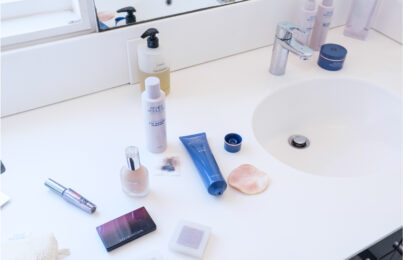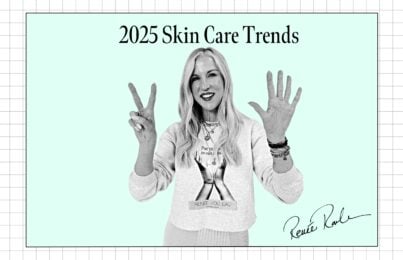If it feels like you’ve tried every moisturizer and thick cream under the sun but your skin still feels dry or tight, one newly trending skincare trick might be the key. TikTok skincare trends admittedly don’t always knock it out of the park, but I think the recent hype around “skin flooding” is well deserved! While it’s not a new idea, skin flooding has repackaged a fundamental skincare concept and helped it reach a wider audience (something I’m all for).
Given this, it’s no surprise that people of varying ages and skin types are praising this easy skincare trick as a great way to provide gentle hydration. The best part? You probably already have everything you need to try this trend in your medicine cabinet. Let’s talk about the benefits of skin flooding and how to go about it for optimal results.
What Is Skin Flooding, and Why Should I Try It?
Skin flooding is the process of layering multiple hydrating products in a specific order to maximize hydration. When we layer products from thinnest (water-based) to thickest (oil based), we are providing a deeper, longer-lasting level of hydration to the skin.
The reason I think this “trend” is so universal is simple: every skin type needs water to be healthy. Skin cells are like fish, and need water to live—even if you have oily skin! People often get confused about the difference between dehydration (a lack of water) and dryness (a lack of oil). While how much oil your skin produces is determined mainly by age and genetics, dehydration is a temporary condition anyone can experience. Skin flooding is the antidote.
Many people think drinking water will hydrate their skin, but the only way to address dehydration in the skin is with topical products.
What Are The Benefits?
The greatest benefit of skin flooding is that it gets hydration into the deeper layers of your skin and keeps it there.
By layering your products from thinnest to thickest, the products with the smallest molecules are going on first (the smaller the molecules, the deeper they penetrate!). This maximizes their efficacy, delivering hydration on a deeper level. Skin flooding immerses all layers of the skin with moisture, helping retain water and keep the skin hydrated. Don’t forget to seal it all in with moisturizer so your hydration is locked in all day or night! By finishing your skincare routine with a thick moisturizer, you help maximize hydration by trapping water in the outermost layer of the skin.
How Does Skin Flooding Work?
Skin flooding is simple—it’s all about applying your products in the correct order.
Step 1: Start With Clean Skin, and Don’t Wait Too Long
The first step in skin flooding is to start with clean, damp skin. This is something I call the Golden Minute Rule. It’s a critical part of my skincare routine, whether skin flooding or not. All this means is that your first product should be applied within a minute of cleansing.
This helps prevent your skin from losing water through a process called transepidermal water loss. During this process, water evaporates from your skin into the air, which can actually cause more dehydration. Immediate application of skincare products after cleansing will allow deeper penetration and guarantee dewy, hydrated skin.
Step 2: Apply Alcohol-Free Toner
Next up, apply an alcohol-free toner. Toner is the perfect product for skin flooding because it’s like giving the skin an instant drink of hydration right after cleansing. For those with particularly parched skin, try applying several layers of toner to really infuse the skin with moisture. Simply wait for each layer to dry down a little bit and repeat the process three to five times.
If you’re still not convinced, check out five reasons to use a toner in your skincare routine.
Step 3: Apply a Serum With Hydrating Ingredients
Next up, a serum. Serums tend to be water-based so they can penetrate deeper into the skin, so a lot of them contain hydrating ingredients by nature. Look for ingredients like hyaluronic acid, glycerin, niacinamide, and tremella fuciformis.
Step 4: Finish With a Moisturizer For Your Skin Type
This last step is key, because without it all that water-based hydration you just pumped into your skin will evaporate. Moisturizer acts like a seal to keep all the goodness in. Lock it all in with a barrier-protecting moisturizer or cream packed with ceramides and emollients, like Hydraboost Rescue Creme.
Who Can Try Skin Flooding?
I encourage all of the 9 skin types to try skin flooding! While those with dry, sensitive skin will benefit the most, especially during the harsh winter months, everyone can profit from deeper hydration. As I said, all skin types need water to be healthy. In fact, one reason I like it for acne-prone skin types is that it relies on layering multiple thin, lightweight products. This is way friendlier for those who are prone to clogged pores than slathering on a thicker moisturizer in hopes of battling dehydration or dryness. (Speaking of which, here are five ways to hydrate oily, acne-prone skin.)
Skin flooding is safe and has virtually no downsides—what are you waiting for?
Curious how other TikTok trends stack up to skin flooding? Read about slugging (and why it’s not suitable for everyone).
Celebrity Esthetician & Skincare Expert
As an esthetician trained in cosmetic chemistry, Renée Rouleau has spent 30 years researching skin, educating her audience, and building an award-winning line of products. Her hands-on experience as an esthetician and trusted skin care expert has created a real-world solution — products that are formulated for nine different types of skin so your face will get exactly what it needs to look and feel its best. Trusted by celebrities, editors, bloggers, and skincare obsessives around the globe, her vast real-world knowledge and constant research are why Marie Claire calls her “the most passionate skin practitioner we know.”



